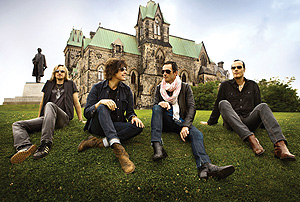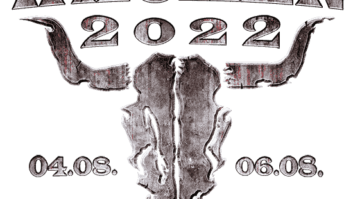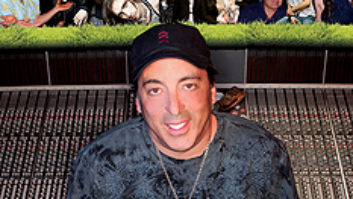
From left: Eric Kretz, Dean DeLeo, Scott Weiland and Robert DeLeo
Photo: Chapman Baehler
In 2003, most Stone Temple Pilots fans thought the band was kaput: Lead singer Scott Weiland continued to battle his heroin addiction and took center stage with super-group Velvet Revolver, while the rest of the bandmembers continued to make music under the name Army of Anyone. Then, in 2008, the band reunited and embarked on a U.S. tour, re-igniting that special spark that these bandmates have had for almost 17 years.
“I think the first step for us was to get together and re-acquaint ourselves with each other and the music, and I think the best way to do that was to get into the songs that are familiar to us—the older material—and what that does is it brings back a lot of memories of being with the people you’re making music with,” says bassist Robert DeLeo, who talked to Mix just a few days after the band’s appearance at SXSW. “Once we brought that back out on the road, I think it was just the natural progression for us to think about making a new record, which we haven’t done in nine years! [Laughs] Time flies.”
The band took a leap in not only trusting each other again as musicians, but in relying on each other to self-produce; for all previous efforts, STP worked hand-in-hand with producer Brendan O’Brien. “I was the cheerleader holding the pom-poms to make this happen,” DeLeo says. “I just thought that many years had gone by and I learned a lot from Brendan—made great records with him and had a great time doing so. I just thought it was time for us [to produce an album], and we’re all very capable of doing this as a band. I’m very proud of it.”
Tracking for the self-titled release commenced at drummer Eric Kretz’s personal studio in downtown L.A., where STP (sans Weiland) started pre-production and demo’ing. Songwriting was handled by DeLeo and his brother, guitarist Dean DeLeo; they compiled both old and new material, working mostly in Kretz’s place.

As the group got closer to laying down tracks, Weiland—who had set up camp at his studio, Lavish, with Don Was—would receive material and track vocals. “Don Was came in and went over vocals with Scott and gave Scott some guidance on where to go with the songs,” DeLeo says. “Don also brought Scott over and got us all together on the same page as far as keys of songs, melodic ideas. Sometimes you need an outside person to do that. So as one of the producers of the record, it was kind of interesting to try to put a record together in separate places, as you can imagine.
“We just got together, played the songs and quickly put them down to see what we had. It was more of a monitoring/demo kind of thing. We didn’t record together. We just took all of our ideas, put them together, sat back and listened and had some melody, vocal and arrangement ideas that we went over. Then we took what we had there and went our separate ways again. It was an interesting way to make a record.
“We’ve been making records since ’92 and we’ve learned an awful lot and we know each other musically where we’re going to go with the songs,” DeLeo adds. “And nine out of 10 times, when we pinpointed what we were going to put on the record, there were a couple of things missing to us, and I think it was more of the upbeat stuff. The first single, ‘Between the Lines,’ that’s a song I wrote as a fill-in-the-blank to round out the record. ‘Cinnamon’ was the same deal. We tracked those at my home studio, Homefry Studio.”
Not only were the tracks being worked on in different spaces, but also on different gear. Robert DeLeo’s space features a restored ’71 Neve 8014 console. (“I really love that board. It sounds really warm and fat,” DeLeo says.) Kretz’s room is centered on an SSL. Both places have Yamaha NS-10 monitors; DeLeo also uses a pair of ADAM speakers. “But the majority of it was on NS-10s and Eric’s also got a set of vintage Auratones that we were playing through once in a while, and they were very helpful in getting everything together.”

Hangin’ at Chris Lord-Alge’s place (with a massive amount of outboard gear), from left: Dean DeLeo, Robert DeLeo, Scott Weiland, Chris Lord-Alge and Eric Kretz
As for mics, DeLeo responds, “Where do we start! I’ve been collecting mics since the early ’90s and it’s one of my passions. My favorite kick drum mic is an AKG D20 and I managed to pick up a couple of those over the years. I’ve actually acquired some from the ’60s, dead stock, still in the box. [We placed a] D20 on the outside and then a 421 on the inside of the kick; 57 on the snare with a 414 underneath the snare. [We used] 57s and KM84 for hi-hats and C12As for overheads. The C12As have a nice depth to them. Royer 122s phantom-powered for overheads; U47s out front and RCA 44 for over the drum set. I kinda look at mics like painting a picture: whatever’s going to work for that space. Used an old Coles ribbon for out front—whatever worked.” Weiland sang through a U47, which DeLeo recalls as the first mic the band bought in the ’90s.
DeLeo’s bass was split into three channels: an early vintage ’61 Bassman A/B’d into an Ampeg VT22 combo, using only the power section of that. “And I run that out into a very rare—I think they only made them for three years, but I found one—1970 Marshall 8×10 cabinet. And then I run that into a Demeter mic direct box. I split those [three channels] up into the Marshall giving me the distortion, the Bassman giving me that roundness and the direct punch of the direct sound. I blend those together into three different channels and adjust according to the song. That’s what I’ve been doing for the past three or four records.”
The one constant in this record-making equation is that all the tracks were loaded onto Pro Tools, and after all the back-and-forth (individual tracking at a personal studio, coming back together to discuss further direction, back to a personal studio, etc.), the final songs were sent to mixer Chris Lord-Alge at his room in Mix LA place (formerly Studio B in Can-Am Studios). Lord-Alge had mixed STP’s “All in the Suit That You Wear” for the Transformers soundtrack, and the bandmembers were intimately aware of, and keen on, his mixing style.
“Back in January [2010], they gave me the test drive,” Lord-Alge recalls. “They gave me the first song, and if they liked it, they said, ‘Okay, let’s keep going.’ We would get two or three tracks at a time to prepare because my staff preps the tracks for me. We like to have plenty of time ahead; it’s not like the file shows up in the morning, we plug it in and go. Plus there’s last-minute vocal edits that are getting e-mailed to us. There have been times when there are vocal issues dropping in before the band shows up and I quickly insert it.”
As for bringing tracks from three separate locations and making it sound as if the band recorded together in one room, Lord-Alge replies: “For us, that’s just normal operation, because the way records are made now who knows where they came from? The thing with STP is, when you hear the songs, you think, ‘This is exactly what it should be and you just get it there’—just from knowing what the band should sound like. For me, they’re more of a Led Zeppelin three-piece than anything because of Dean; he’s more of a Jimmy Page for our times. All I was thinking about was Led Zeppelin and how I would mix Led Zeppelin: Make it a little less polished and more about the riff than the melody. The guitars and vocals had to be 50/50. A lot of times, the song just dictates that you make it more of a vocal-heavy mix because of the song’s structure.”
Lord-Alge mixed on his SSL 4k 72-channel console (“this is what makes rock ’n’ roll”), monitoring through Yamaha NS-10Ms, Infinity subwoofer and M&K powered speakers. “More important is the boom box, which is a Sony ZS-M1 MiniDisc player,” Lord-Alge adds. “That’s what the band tends to like best because that’s like your computer speakers, but not that crappy. The most important thing is to hear how it’s going to show up on a smaller medium because 90 percent of the people are going to hear it on a small medium: ear buds, computer speakers, car stereos. Not to say that we’re making it lo-fi; we’re just making sure the balances are there.”
The mixer also made use of his arsenal of outboard gear: Pultecs, 1176s, etc. For their “larger, bigger, better and louder” mantra, Lord-Alge selected choice pieces from his “700U” of outboard. “All my plug-ins are installed with a power screwdriver. The thing with STP, I’m using vintage reverb, vintage analog delay. All original 224 reverb from the ’70s, original Marshall slap tape delay, a Rev-1 reverb, the original EMT 246 from the late ’70s. All stuff with character. Even an Ursa Major Space Station. Just using those flavors, you can’t re-create that in the box.”
Dean DeLeo and Kretz were involved in the mix; Robert DeLeo chose to stay at home and have the tracks e-mailed to him. “I think what I’ve learned over the years is to not tweak my own music,” he explains. “And for me, it was better if I was down at my house and I had the mixes sent to me. I was in an environment that I was used to. I think that when you get into a mixing studio, it’s supposed to sound good, so I get a little fooled by being in a foreign place and listening to it because I’ve been in the situation before where it’s like, ‘This sounds great,’ but when I get it back to my house, it didn’t sound as good as I thought it did. And that’s the beauty of the technology. You can actually get something sent to you over the Internet and sit in the comfort of your own home or go out in your car and check it out. Listen to it on your home stereo.”
Once final mixes were approved (total mixing took about nine days), tracks were sent to Ted Jensen at Sterling Sound, whom Lord-Alge uses for all of his projects.
Reflecting on the final product, which was released in late May, Robert DeLeo sums it up: “I think ultimately we’ve been conscious of making a great record, a great listening experience from top to bottom. I think producing is many, many different facets, and I think producing is ultimately getting to what you call a finished product. Dean and I were hard at work getting this finished! I like doing things quickly and getting them out and getting a performance. I never took myself out of the ear of the listener. I think I’ll always be a fan of listening to music, so if I can incorporate the ‘listening to the music’ facet in the music that I make, I think it makes great music.”


